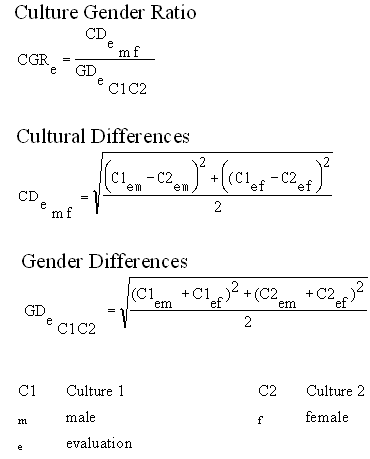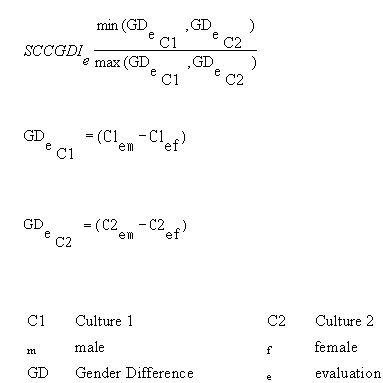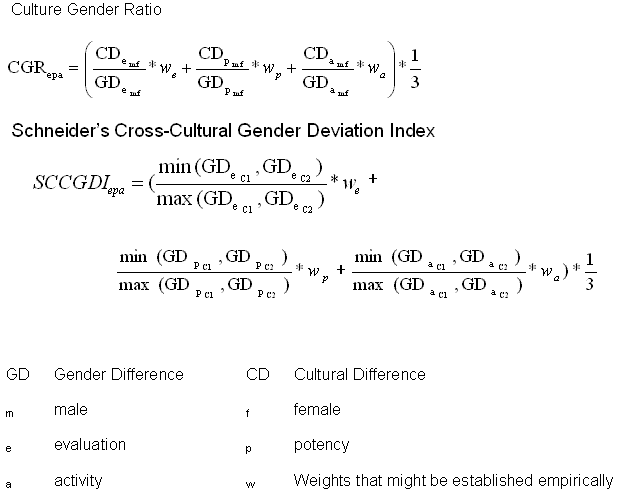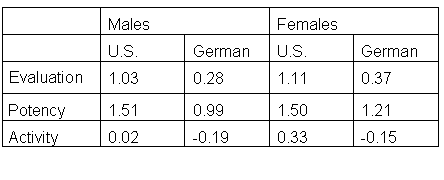

What are the most appropriate ways to gauge cross-cultural differences? This paper develops a methodological tool where gender serves as a intra-cultural standard of comparison for the analysis of cross-cultural differences. I present a Culture Gender Ratio (CGR), and demonstrate it's utility through the analysis of authority and eroticism. I also apply Schneider's Cross-Cultural Gender Deviation Index (SCCGDI) to control for culturally disproportionate gender differences. I demonstrate the conditions under which the Culture Gender Ratio (CGR) and its control index (SCCGDI) aid in interpretation of cross-cultural differences where researchers are familiar with one - but not the other - culture being compared.
A common problem of cross-cultural research concerns how to interpret cross-cultural differences in one’s data. Even if the researcher is able to pinpoint the domains where differences occur, analyzing the statistical significance of those differences is often unclear.
As social scientist we may measure those differences with rigorous techniques. An exemplar is to employ semantic differential ratings of affective meaning to measure the representations of sentiments. Yet this begs the question: How should one interpret cross-cultural differences that are found? For example, are cross-cultural differences of one unit on an evaluation scale of –4.33 to 4.33 significant when comparing authoritarian identities across North America and Germany?
To imagine the magnitude of cross-cultural differences, I suggest that it is helpful to gauge these differences with the help of known subcultures. In principle, we could use all kinds of subcultures as measurement rods. I chose gender because it is widely accessible and well researched – particularly within the tradition of measuring affective meaning. For example, North Americans rate identities clustering under the general rubric of “authorities” nine time more positively than Germans, compared to differences among American men and women.
Before I introduce a CGR and its control-index, the SCCGDI, I briefly introduce measurement of affective meanings of identities.
Identities reflexive are self-meanings. To the extent that they involve others, they reflect structural properties. According to Mead (1913, 1934) and Cooley (1922), reflexivity is a necessary prerequisite for the construction of a self. Mead’s concept of “self is a self-conscious ego that merges in the interaction between the “I” and the “me” (1913, p.378).” Mead stated that the development of the self is dynamic, a process of development that was later systematized by Strauss (1994) who, in his biographical historical methodology, emphasized the importance of social histories to identity salience and confirmation (Burke 1980; Stryker 1980; Stryker and Burke 2000).
Structural meaning is so central to the affective representation of identities that social structure serves as a schema for cognitive classification like authority or eroticism (Schneider 1999a). The concept of reflexivity is important for bridging an individual’s concept of identity and structural concepts like authority. This link is necessary because identities consist of internalized meanings and expectations attached to roles. Roles, by contrast, provide the external links between social positions (like more or less authoritative and authoritarian positions) within any social structure.
In one of the largest research projects ever conducted in the social sciences, Osgood, May and Miron (1975) found evidence for the cross-cultural universality of the evaluation (E), potency (P), and activity (A) dimensions (EPA dimensions) of affective response. Semantic scaling on EPA dimensions allows valid and reliable measures of affective meaning of sentiments (Osgood 1962; Osgood et al.1975). The EPA dimensions are valid and reliable measures of affective meanings that explain large portions of variance in sentiments. Poles of the three-dimensional semantic scales are defined by the following adjectives:
Evaluation: good, nice - bad, awful
Potency: big, powerful - little, powerless
Activity: fast, young, noisy - slow, old, quiet
Intervals between the points labeled as “neutral,” “slightly,” “quite,” and “extremely” are coded with near-interval differences of 1.0. The differences between the scale endpoints: “extremely” and “infinitely” are coded 1.33, corresponding to visual scale distances. This makes it a continuous scale ranging from -4.33 to +4.33. These scales are reflected in modern techniques of data collection (Heise and Lewis 1988, Heise 2001) that are used by the author.
The fundamental work of Osgood established the principle of affective representation and the three dimensional semantic scaling of affective meaning as a cultural universal. It also demonstrated that ratings on these scales are highly discriminating measures of culturally specific meanings. Both properties – the cultural universality of the instrument and the cultural particularity of the measurements - are core prerequisites for valid cross-cultural comparisons.
As a gauge of cross-cultural differences, I constructed a Culture Gender Ratio (CGR) that compares cultural differences relative to gender differences. A person familiar with gender differences in one of two cultures being compared can infer the magnitude of cultural differences even if she is not familiar with the other culture. As a CGR approaches zero, gender differences are stronger than cross-cultural differences. A CGR of one implies that cultural differences are of the same magnitude as gender differences. A CGR larger than one indicates how much larger cross-cultural differences are to the gender effects of another culture. A CGR of two, for example, indicates that cross-cultural differences are twice the magnitude of gender differences in cultures used to standardize the measure.
Before this ratio can be used as a valid tool for the investigator unfamiliar with one of the cultures in comparison, the fact that gender differences in both cultures may not be equivalent has to be taken into account. Just as we use standard deviations for judging validity in the comparison of means, we can use a measure of cross-cultural comparisons of gender differences to gauge the validity of generalizations based on the CGR. Schneider’s Cross-Cultural Gender Deviation Index (SCCGDI), controls precisely for disproportionate gender differences that can impact generalizations from the CGR.
The SCCGDI varies between zero and one, where zero indicates extreme gender dissimilarity in the affective meaning of two cultures, and one suggests no gender disparity in both cultures. As the SCCGDI approaches zero, the validity of the CGR is compromised. As the SCCGDI approaching one, gender differences used in the CGR allow more valid estimates of cross-cultural differences.
Figure 1 shows the formulas for computing a CGR for the evaluation dimension only. Figure 2 displays Schneider’s SCCGDI for the evaluation dimension although easily extended to the potency and activity dimensions. Figure 3 exhibits the general model with CGR and SCCGDI computations for all three dimensions of affective meaning. Note that EPA dimensions might be weighed according to relative centrality of each dimension for the determination of cross-cultural differences in the formula for a CGR. These weights might be empirically established in different ways: generically for all cultures, specific to particular cultures under examination, or particular to the concepts used in a cross-cultural comparison.
Figure 1. Formulas to Determine the Culture Gender Ratio for the Evaluation Dimension1

Figure 2. Schneider's Cross-Cultural Gender Deviation Index for the Evaluation Dimension

Figure 3. General Formulas for Computing the CGR and SCCGDI for all EPA Dimensions

Cross-cultural differences and gender differences can be pronounced in some domains but absent in others. This will be demonstrated in the following applications of these two indices in the domains of authority and eroticism previously investigated by Schneider (1996, 1999b, 2002). In the erotic domain, a third application will be demonstrated for identities that lack of eroticism (Schneider forthcoming).
Schneider (1996) designed a German data set to be comparable to an older U.S. study (Heise 1978). It used the same instrument for measuring affective meaning based on the semantic differential technique translated into German. An existing U.S. dictionary was used for the construction of the German stimuli where concepts were translated into German by a fluent, bilingual, native German speaker. In a blind back-translation another bilingual person translated the German concepts back into English. All concepts whose back-translation matched the original English word were selected for further studies. The remaining concepts were examined by a native of the U.S. culture, and words whose back-translations were identical or synonymous with the original also were selected. About 420 well-translated identity concepts were used as stimuli for data collection in Germany.
Originally, I recruited 400 subjects from Mannheim University and two Gymnasiums in the large, industrial city of Mannheim. This German sample replicates age and number of school years completed in the U.S. studies (Schneider 1996). Pupils who were in their last year in the Gymnasium system were added to the lower-level university students (Vordiplomstudenten) to match the U.S. undergraduate population used to create American lexicons of affective meaning.
In December 1998, I used the same instrument to collect affective meaning data at a university in west Texas. In this case, 420 students rated identities common to the older US sample and the German one. This method lessens confounding of stimuli, instrumentation, and sociodemographics of the subjects, as each were essentially identical to the German sample.
I addressed the possibility that the Texas sample is not representative of the United States by analyzing the ratings of authority-identities by another convenience sample of 60 undergraduate students from a large, urban university in eastern Missouri. Contrary to the charge that Texans are different from the larger American population, analyses found no statistical bases that Texans are more authoritarian than eastern Missourians. Although I do not suggest that the Texan data is representative of all Americans, the hypothesis that Texans are atypical of North American ratings of affective meanings is disconfirmed.2
I designed the German data collection procedures for optimal cross-cultural comparisons with the American lexicons. That is, I maximized equivalence between the U.S. and German samples rather than the representativeness of either sample. Such studies are “faced with a dilemma common in cross-cultural work: maximizing representativeness within usually means minimizing equivalence between” (Osgood 1974: 241). Subjects serve as cultural informants who are highly representative of their general national culture (Romney et al 1986). Within this context, I maximize the representativeness of Americans and Germans in the following cross-cultural comparisons.
I conducted an additional empirical study to ensure a valid domain-specific selection of identities. One-hundred and forty undergraduate informants classified identities into categories such as authority or erotic. Subjects classified a list of 420 identities as definitely an authority (coded as 0), maybe an authority (coded as 1), definitely not an authority (coded as 2). For the following investigation of authority-related identities 1.5 was used as a cutoff point. I selected 69 authority-related identities, like attorney, boss, disciplinarian, expert, judge, manager, principal or supervisor using this procedure.
A similar procedure produced a set of erotic identities that – in an effort to clarify the adjective erotic – are also described as sexual. Sixty-eight undergraduates served as informants; they classified the complete set of 420 identities for their erotic connotations using a three-point scale: “definitely sexual-erotic (2),” “maybe sexual-erotic (1),” or “definitely not sexual-erotic (0).”
The same 1.5 cutoff point produced 10 sexually explicit identities: Call girls, whores and prostitutes are professional identities of the oldest profession that is now illegal in 49 American states. Topless dancers, porn stars, and strippers are legal professional identities representative of the sexual entertainment industry. Identities such as bisexual, adulterer, playboy and intimate can be seen as a third category of private erotic identities.
There are far more identities among the 420 identities that lack sexual or erotic connotations than identities rated as explicitly sexual or erotic. Therefore, I used the inverse cutoff point (0.5) to identify the large number of identities that lack sexual or erotic connotations. By setting the cut-off point equal to or smaller than .5, 46 of the 420 entire set of identities fall into the non-sexual and non-erotic category. Each of these three sets of connotatively similar identities (related to authority, eroticism, or non-eroticism) are now ready for analysis using the CGR and SCCGDI.
Power may be viewed as the subjective probability of a person (or some number of persons) to realize his, her, or their own will in social action – even against the resistance of others who are participating in the action. Being coerced is unpleasant, and generally leads to resentment toward the coercer. However, if the other’s coercion is legitimated, then a potent identity may be evaluated positively.
The ideal typical rating of authority is, therefore, potent and highly evaluated. Since authorities do not have to communicate their status through expressive actions the ideal typical EPA pattern can be described as high on evaluation and potency, and neutral on activity according to the following three rules.
1. High P: Persons experience subjugation to highly potent acts negatively – particularly when they feel it is illegitimate.
2. High E: Subjugation to legitimately potent acts are experienced as relatively high in evaluation.
3. Low A: If power is understood to be legitimate, it does not have to be shown in expressive actions
Since the evaluation dimension is most central in judging the authoritativeness (Schneider 1999c) the following comparisons will be simplified by focusing only on the evaluation dimension.
Table 1 aids testing of these three rules for distinguishing ideal typical affective meanings toward authorities in the U.S. and Germany. Legitimate authorities are rated roughly three-fourths of a point higher in evaluation by Americans than Germans. That is, the average American rates the 69 authority-related identities as “slightly good” but Germans rate the same concepts as close to neutral in goodness.
These 69 authority-related identities are also rated more potently by Americans than Germans. The same concepts are viewed as close to neutral in activity by both German and American informants, regardless of sex of the rater. Thus, American males and females appear to follow the three ideal-typical rules depicted above even more than Germans, in spite of the old American adage “Distrust authority.”
Table 1: Average EPA of 69 Identities rated to be Authorities

Nevertheless, Table 1 gives no clear idea about the magnitude of these American-German differences in EPA ratings. A CGR of 8.76 indicates that the American-German differences are nearly 9 times more pronounced than the within-culture gender difference. To see if this interpretation is valid and not distorted by disproportional gender differences in both cultures, I computed a SCCGDI using this data. As evident in Table 1, females are more likely than males to legitimize authority in both cultures. Since the gender difference is similar for both cultures, the SCCGI equals 0.89. With a scale ranging from 0 (extreme gender disparity) to 1 (no gender disparity), the SCCGDI of 0.89 indicates that using gender as a base for comparing American with German cultural differences in the estimation of differences in the authority domain is indeed a valid means of comparison.
Prior studies (Schneider 1996, 1999b) indicated that erotic identities are especially stigmatized in North America. New data collected in Texas, shown in Table 2 indicates that this is also true today. Women in both cultures view the 10 erotic identities found in both the German and American data sets as stigmatizing. However, Americans are also more likely to view these ten erotic identities as stigmatizing. Thus, the question arises as in the authority-related analysis of the last section: Are the magnitudes of these cross-cultural differences adequately expressed with the CGR and SCCGDI measures I introduced earlier?
Table 2: Average Evaluation of 10 Identities rated to be explicitly erotic

As with the earlier authority-related analysis, I wondered whether within-culture gender differences provides an adequate standard of comparison for judging the magnitude of cross-cultural differences in the erotic data presented in Table 2. The CGR of 1 suggests that cross-cultural differences are as pronounced as gender differences. However, the corresponding SCCGDI of .47 challenges the validity of this generalization because this measure indicates that the gendered difference shown in Table 2 are substantially different for each culture.
That is, gender differences are much stronger in North America than in Germany. Using the GDR as an indicator for cross-cultural differences (1) overestimates cross- cultural differences for Americans, and (2) underestimates cross-cultural differences for Germans.
Schneider (forthcoming) demonstrates that there is a tendency to stigmatize identities with an extreme lack of sexual or erotic connotations. Stigmatization of identities without such affective meaning is much more pronounced in Germany than in North America. Table 3 shows that while this stigmatization is similar for males and females in Germany, gender differences in North America are extremely pronounced. This culture-specific gender difference is indicated in an extremely low SCCGDI of 0.24 that cautions against reliance on the corresponding CGR equal to 3.19.
Table 3: Average Evaluation of 46 Identities Rated to be Least Erotic

The unchecked interpretation of the CGR is greatly distorted in this example. Taking within-culture gender differences as a benchmark, Americans cross-cultural differences are substantially underestimated by the CGR. Conversely, Germans cross-cultural differences are grossly overestimated.
Gender differences are most useful in estimating the magnitude of cross-cultural differences as the SCCGDI approaches unity. However, using the CGR as an estimate of the magnitude of cross-cultural differences deteriorates as the SCCGDI approaches zero. That is, the CGR predicts poorly when gender differences are disproportionate across cultures. Schneider’s Cross-Cultural Gender Deviation Index (SCCGDI) provides a serviceable estimate of such gender disparity cross-culturally. Just as the standard deviation aids in the comparison of means, the SCCGDI serves as an indicator for the validity of generalizations based on the CGR.
To demonstrate the helpfulness of the CGR in cross-cultural comparison and the importance of the SCCGDI as a control, I provide three examples. In the first application to the authority domain, the GDR indicates that cross-cultural differences between Germany and North America are nearly nine times as pronounced as gender differences. A corresponding SCCGDI of 0.89 indicates that this conclusion is largely unbiased, meaning that it is just as valid for an American as for a German to use this generalization.
The second application focused on the domain of eroticism, where I posit that cross-cultural differences are just as pronounced as gender differences (CGR=1). However, a SCCGDI of 0.47 cautions against placing much faith in this generalization.
In the third application I found evidence for even less faith in using the CGR to compare cross-cultural differences in the domain of non-erotic or non-sexual identities. The SCCGDI of 0.21 indicates such an extreme distortion that the CGR (=3.19) should not be used to quantify the magnitude of cross-cultural differences. In the case of identities that lack sexual or erotic connotations, gender differences are so disproportionate cross-culturally that they deserve special investigation.
The hype about globalization makes many of us believe that cultural differences have largely vanished (e.g., Ritzer 1999, 2000). At the same time there is an extremely strong emphasis on gender differences in the current sociological literature of gender roles (Belknap &Leonard 1998, Goffman 1976, 1979), peer culture and socialization (Eder 1995), political participation (Burns et al. 2002), communication style (Pease 2001, Wood 2000), violence (Schwartz & Rutter 1998), mood and anxiety disorders (Leibenluft 1999), brain and learning differences (Gurian et al 2001), and many other fields.
How should culture become internationally homogeneous while it is becoming nationally diverse? It might be argued that with an increase in globalization, people loose existing icons of cultural identification. This anomic sate might encourage them looking for new properties that define their uniqueness. Especially in cultures that allow or even encourage individualism, globalization can lead to local diversification. Globalization can motivate people to differentiate themselves using properties like gender that receive an increasingly differentiated focus.
The task for cross-cultural researchers is not just the identification of areas of globalization and diversification, but also estimating the relative strength of these developments. The author expects that both, gender difference and globalization arguments are currently overstated ideologies in the North American social sciences. Following the Wertefreiheitstheorem of Max Weber, the author assumes the position that while it is largely impossible (and not necessarily preferable) for researchers to shed values and ideologies in their selection of topics, they should use rigid empirical methodology to minimize the influence of these ideologies on the sociological investigation. Researchers who are blinded by gender or globalization ideologies can benefit from joint applications of the CGR and the SCCGDI in the empirically grounded interpretation of cross-cultural differences.
Belknap, P. and Leonard, W. M., II, (1991)” A Conceptual Replication and Extension of Erving Goffman’s Study of Gender Advertisements.” Sex Roles 25: 103-118.
Burns, N., Lehman, K. Schlozman, and S. Verba. (2002). The Private Roots of Public Action: Gender, Equality, and Political Participation. Harvard University Press.
Burke, P. J. (1980). “The self: measurement requirements from and interactionist perspective.” Social Psychology Quarterly 43:18-30.
Cooley, C. H. (1922) Human Nature and Social Order. New York: Scribner’s
Eder, D. (1995). School Talk: Gender and Adolescent Culture. Rutgers University Press.
Goffman, E. (1976). “Gender Advertisements.” Studies in the Anthropology of Visual Communication 3: 69--l54.
Goffman, E. (1979). Gender Advertisements. Cambridge, MA: Harvard University Press [hardback]; New York: Harper and Row [paperback].
Gurian, M., Henley, P. and T. Trueman. (2001). Boys and Girls Learn Differently!: A Guide for Teachers and Parents. Jossey-Bass Press.
Heise, D.R. (2001). “Project Magellan: Collecting Cross-cultural Affective Meanings Via The Internet.” Electronic Journal of Sociology 5,3. https://sociology.org/content/vol005.003/mag.html
Heise, D. R., and E. M. Lewis. (1988). Introduction to INTERACT. Documentation for the Programs ATTITUDE and INTER-ACT. Raleigh, N.C: National Collegiate Software Clearinghouse.
Heise, David R. (1978). Computer-Assisted Analysis of Social Action. IRSS Technical Papers 3. Chapel Hill, NC: Institute for Research in Social Sciences.
Leibenluft, E. (1999). Gender Differences in Mood & Anxiety Disorders: From Bench to Bedside. Amer Psychiatric Inc.
Mead, G. H. (1913). “The Social Self.” Journal of Philosophy, Psychology, and Scientific Methods 373-380.
Mead, G. H. (1934). Mind, Self, and Society. Chicago: University of Chicago.
Osgood, C. E. (1962). “Studies of the Generality of Affective Meaning Systems.” American Psychologist 17: 10-28.
Osgood, C. E., W.H. May and M.S. Miron. (1975). Cross-Cultural Universals of Affective Meaning. Urbana: University of Illi-nois.
Pease, B. and A. Pease. (2001). Why Men Don’t Listen: And Women Can’t Read Maps: How We’re Different and What to Do About It. Broadway Books.
Ritzer, G. 1999. Enchanting a Disenchanted World: Revolutionizing the Means of Consumption. Thousand Oaks: Sage.
Ritzer, G. 2000. The McDonaldization of Society. Thousand Oaks CA: Pine Forge Press.
Schneider, A. (1996). “Sexual-Erotic Emotions in the U.S. in Cross-cultural Comparison.” International Journal of Sociology and Social Policy 16: 123-143.
Schneider, A. (1999a). “Emergent Clusters of Denotative Meaning.” Electronic Journal of Sociology: 4, 2.
Schneider, A. (1999b). “The Violent Character of Sexual-Eroticism in Cross-cultural Comparison.” International Journal of Sociology and Social Policy l8:81-100.
Schneider, A. (1999c). “US Neo-Conservatism: Cohort and Cross-Cultural Perspective.” International Journal of Sociology and Social Policy 19:56-86.
Schneider, A. (2002). “Professional Identities and Culture-centric Behavior, a Computer Simulation in Multi-cultural Corporations.” Organization Behavior 23: 105-132.
Schneider, Andreas. Forthcoming. “A Possible Link Between Stigmatization of Sexual-Erotic Identities and Sexual Violence.” Sexuality & Culture.
Schneider, A. and D. R. Heise. (1995). “Simulating Symbolic Interaction.” Journal of Mathematical Sociology 20:271-287.
Schwartz, P. and V. E. Rutter. (1998). The Gender of Sexuality: Sexual Possibilities. Altamira Press.
Strauss, A. (1994). “Identity, Biography, History, and Symbolic Representations.” Social Psychology Quarterly 58: 4-12.
Stryker, S. (1980). Symbolic Interactionism: A Social Structural Version. Menlo Park CA: Benjamin Cummings.
Stryker, S. and P. J. Burke. (2000). “The Past, Present, and Future of an Identity Theory.” Social Psychology Quarterly 63: 284-297.
Wood, J.T. (2000). Gendered Lives : Communication, Gender, and Culture. Wadsworth Pub Co.
1. The CGR, CD, and GD can be computed separately for the potency and activity dimension as exemplified in the formulas for the evaluation dimension. Figure three shows the general formulas that take all three dimensions into account for computing the CGR and SCCGDI.
2. A separate manuscript demonstrating that stereotypes against Texans are prevalent even in academe is currently under review elsewhere. I use semantic differential ratings in this paper to systematically disconfirm stereotypes of Texans and to demonstrate that Texan data can be used with the same benefits and limitations as data from other states. I thank Professor Herman Smith for providing the data from eastern Missouri.
© Electronic Journal of Sociology